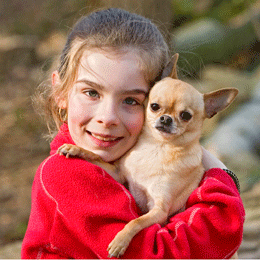Dogs and children: Helping them understand each other and be safe together.
Both dogs and children need to be taught how to behave around each other so that they can live happily and safely together.
 Teaching children about the family dog
Teaching children about the family dog
There are a few basic things you can teach your children about what dogs do and don’t like:
- Dogs can get easily over excited, scared or confused if you are loud and move quickly, instead be calm and quiet around your dog at all times.
- Dogs often don’t like having their heads patted or their paws and tails touched as these are sensitive areas. Try patting them on the back or scratching their necks gently.
- Dogs need quiet time to relax just like people so if your dog is curled up in its bed or kennel let them relax and don’t disturb them.
Teaching children about unfamiliar dogs
There are a number of things that you can teach your child in order for them to interact better and more safely with dogs they don’t know:
- Never approach a dog you don’t know without first asking the owner. The dog may be nervous or aggressive or have other problems you don’t know about.
- Once the owner says its OK, approach the dog quietly from the front or side where they can see you and let the dog reach out and sniff and greet you before you try to pat it.
Teaching dogs about children
Dogs need to be used to the various behaviors of children and also recognize children as dominant pack members. In order to achieve this you need to:
- Socialize your dogs with a number of children of various ages making sure the dog is well under your control. Praise and treat good calm behavior and give a 3-minute time out for bad behavior such as barking or jumping. Alternatively use the alarm-no-command method from your secrets to dog training manual to redirect their attention.
- Make sure you don’t let your dog play tug-of-war games with children as they are often much stronger and will win which can lead to the dog displaying dominant behaviors.
- Keep up alpha training and involve the children too. For example make sure that dogs do not walk through doorways before them and do not eat before them.
- Dogs respond to sounds of words rather than the words themselves and need distinct words for distinct acts such as a different word for ‘down’ as in lie down and for ‘down’ as in off the couch. To avoid confusing your dog, particularly a young dog, its best that children don’t do the training.
Dogs often love children and the play and fun they bring, while children can learn a lot about taking care of others, as well as enjoying the gift of companionship that dogs bring. Working with these basics, children and dogs should be able to live happily together and get the most out of their relationship.
All the best,
![]()
Daniel Stevens and the Secrets to Dog Training Team
"Secrets to Dog Training - STOP Dog Behavior Problems!"
http://www.kingdomofpets.com/dogobediencetraining/
P.S. Forward this Newsletter to a friend
If you have a friend you think may be interested in training their dog or solving a particular dog behavior problem, please feel free to forward them this Newsletter.
P.P.S. Remember – you have full access to our Members’ Forum
Because you are a Member of ‘Secrets to Dog Training’ you have full access to our Members’ Forum. If you have a dog behavior question or a related problem, you are most welcome to bring it to the Forum. Post a detailed description for our trainers and fellow Members to read. Within 1-4 working days you will see recommendations on how to solve it once and for all.
If you haven’t already registered for the Forum, you can do this from the Members’ Area: http://www.kingdomofpets.com/dogobediencetraining/members/ or you can go straight there by clicking here – http://www.kingdomofpets.com/dog/forum/
